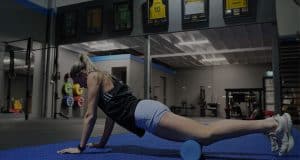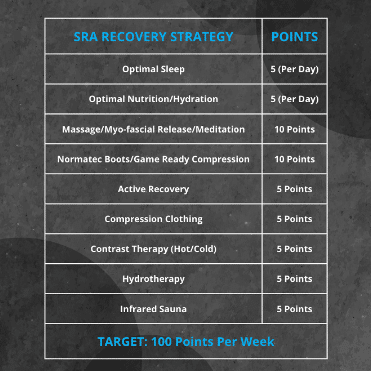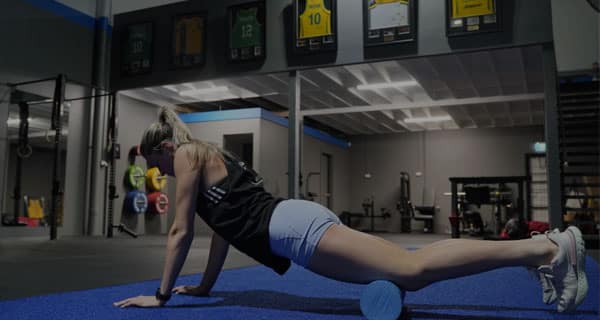
The Importance of Athlete Recovery
Recovery is an essential component of athletic performance, involving the restoration of both physiological and psychological processes after training or competition. The foundation of adequate recovery begins with proper sleep, nutrition & hydration, followed by many other strategies which may further enhance the process.
Sleep
Objective:
It is recommended that a minimum of 8 hours of sleep per night is acquired for optimal recovery and growth which allows for hormone regulation, muscle repair, memory consolidation, managing inflammation and restoring energy.
Sleep Deprivation:
Studies have shown that a lack of sleep has negative effects on performance, mental wellbeing, metabolism, immune function and cognitive function. Contributors to poor sleep among athletes include training and competition times, intensity of exercise, travel, stress, anxiety and muscle soreness.
Strategies for improved sleep:
- Establish a consistent sleep-wake pattern.
- Limit afternoon caffeine (less than 9 hours prior to bed time)
- Avoid naps in the afternoon (Later than 4pm)
- Mid day ‘power naps’ of 15-30mins may provide a quick boost in alertness, cognitive function, and physical recovery without causing grogginess.
- Create a non stimulating pre-bed routine:
- Avoid use of electronic devices at least 30 mins before bed. These devices emit blue wavelength light, which reduces the release of melatonin, a key hormone for regulating the sleep/wake cycle.
- Maintain a cool, dark, and quiet bedroom.
- Find a relaxing task such as meditation, warm bath, mobility routine, light reading or journaling.
Nutrition
The role of nutrition and hydration during recovery is necessary to appropriately refuel and rehydrate the body, promote muscle repair and growth, and support immune system function. Nutrition is especially important in-season when training and competitions are in close succession.
Timing of Nutrition
The timing and amount of nutritional intake post exercise varies depending on the athlete and type of exercise carried out.
As a general guideline, it is advised to consume a combination of meals rich in protein and carbohydrates within the first 60-90 minutes post exercise, along with drinking plenty of water and electrolytes. This is shown to maximize nutrient absorption, leading to muscle repair and replenishment of glycogen stores.
Inadequate Nutrition:
Poor nutrition may lead to:
- Increased fatigue
- Reduced performance at next training/competition
- Suboptimal gains from session
- Increased muscle soreness
Strategies for Improved Nutrition:
- Balanced meal prepping (include colorful fruits and vegetables)
- Prepare electrolyte drinks for post exercise hydration
- Prepare protein shakes/smoothies
- Bring snacks such as protein bars, trail mix, fruit etc
Active Recovery & Mobility
Active recovery and mobility involves light movement of the body post exercise, rather than complete rest.
Examples:
- Steady-State cardio (walks, bike, swimming, rowing etc)
- Yoga circuits
- Light weights
- Mobility circuits
- Foam Rolling
Benefits:
- Increase blood flow
- Reduced muscle soreness
- Maintain movement and flexibility
- Improved muscle recovery
- Provides a mental break
- Injury prevention
Approaching Active Recovery:
- Plan at least one active recovery day per week
- Only requires 15-30 minutes of activity
Contrast Therapy
Contrast therapy is a recovery strategy that involves alternating between heating up the body and cooling it down rapidly, stimulating two physiological processes. Exposure to hot water leads to dilation of the blood vessels, while the cold water leads to constriction of the blood vessels in a quick succession, resulting in a pump-like effect.
This leads to:
- Increased rate of blood flow
- Management of inflammation
- Reduction in muscle soreness
- Improved recovery time
- Improved psychological readiness
- More efficient waste removal
- Heightened functionality
Method:
- 3 minutes hot
- 1 minute cold
- Repeat 3-5 cycles
- Always finish on cold
**There are many methods available on the internet, test them out and find what works best for you**
Massage/Myotherapy
Massage therapy has been shown to positively impact athlete recovery in various ways. It improves blood circulation, facilitating the delivery of oxygen and nutrients to the muscles, along with the removal of lactic acid and other toxins that accumulate in the muscles. This leads to reduced muscle tension. Additionally, it can promote flexibility and range of movement by breaking down adhesions and scar tissue. Other benefits include increased relaxation, stress relief, decreased recovery time and aids with injury prevention.
We recommend seeking a massage every month for amateur athletes and once or twice per week for professional athletes.
Meditation
The key to recovery is the ability to switch as soon as possible from a catabolic state (breaking down tissue) to an anabolic state (building tissue). The faster you can do this process the more capable you will be of recovering from your workouts.
This can be done in the form of simply lying on your back and spending 2-3 minutes focusing on deep belly breathing (in through the nose and out through the mouth) or through more advanced variations such as meditation.
There are many helpful videos and apps on the internet which can introduce you to meditation.
Infrared Sauna
Infrared saunas use an infrared heater to emit light which is absorbed by the body to produce heat. We have found this to be an effective means of recovery and recommend using them 4-6 times a week. However it’s essential to listen to your body and adjust the frequency accordingly.
Benefits:
- Aids waste removal
- Strengthens immune system
- Relief from muscle soreness
- Improved sleep
- Relaxation
How to use:
- Ensure to stay hydrated before, during and after the sauna
- Optimal temperature is 55-60 degrees celsius
- Limit to 15-40 minute blocks
Compression Boots
NormaTec is a popular system used by many athletes across the world. It involves pulsed compression to create a restorative massage, enhancing circulation post exercise. This leads to increased blood flow & lymphatic return. Athletes have also found that using the boots for only 20-30 minutes reduces pain and stiffness, along with overall reduced recovery time.
Foam Rolling & Massage Guns
Foam rolling is a form of self massage in which an athlete uses their bodyweight to apply pressure to targeted muscles, using a foam roller device. This should be used as a tool to get your body active as the benefits are seen to be acute. It is recommended to foam roll at the start of a warm up or throughout the day if your body feels achy/stiff.
Benefits:
- Decrease tissue stiffness
- Increase flexibility
- Flush out metabolic waste
Massage guns are also a beneficial tool for short-term recovery outcomes. Although they do not directly increase mobility, it has been shown that massage guns help with fascial length and stimulating the nervous system.
Conclusion
As a general guide to optimal recovery, it is recommended to follow our 100 point recovery strategy below:

References:
- Gardiner, C., Weakley, J., Burke, L.M., Roach, G.D., Sargent, C., Maniar, N., Townshend, A. and Halson, S.L., 2023. The effect of caffeine on subsequent sleep: A systematic review and meta-analysis. Sleep medicine reviews, 69, p.101764.
- S.Halson in NSCA’s Essentials of Sports Science 2021 ‘The Recovery Pyramid’ Sports Dieticians Australia, ‘Recovery Nutrition Fact Sheet’
- Wiewelhove, T., Döweling, A., Schneider, C., Hottenrott, L., Meyer, T., Kellmann, M., Pfeiffer, M. and Ferrauti, A., 2019. A meta-analysis of the effects of foam rolling on performance and recovery. Frontiers in physiology, 10, p.449926.
- Ferreira, R.M., Silva, R., Vigário, P., Martins, P.N., Casanova, F., Fernandes, R.J. and Sampaio, A.R., 2023. The effects of massage guns on performance and recovery: a systematic review. Journal of Functional Morphology and Kinesiology, 8(3), p.138.
- Sands, W.A., McNeal, J.R., Murray, S.R. and Stone, M.H., 2015. Dynamic compression enhances pressure-to-pain threshold in elite athlete recovery: exploratory study. The Journal of Strength & Conditioning Research, 29(5), pp.1263-1272.

